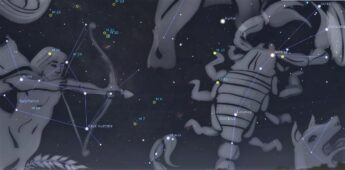This Week’s Sky at a Glance, 2023 July 1 – July 8
This Week’s Sky at a Glance, 2023 July 1 – July 8
With the Milky Way becoming prominent on summer evenings, binocular stargazing is a great way to pass the time. From Cygnus heading south the Milky Way is split by the Great Rift, a region where the starlight between us and the centre of our galaxy is blocked by vast dust clouds. The western side of the Milky Way runs through parts of Lyra and Ophiuchus to Scorpius, and the eastern side runs through Aquila and Scutum to Sagittarius.
A good place to start observing is with orange Antares in Scorpius. Check out the colour of this supergiant star, and pick out the globular cluster M4 in the same field of view to its right. East of Scorpius is the Teapot asterism that makes up much of Sagittarius the Archer. If you extend the two stars at the top of the Teapot’s spout to the right you will find M6, the aptly named Butterfly Cluster. To its lower left is a large star cluster called M7 or Ptolemy’s Cluster. To the right of M7 is a pair of bright stars, Shaula and Lesath, which marks the stinger of Scorpius. They have been nicknamed the Cat’s Eyes.
About a binocular-field width above the Teapot’s spout you will find a fuzzy patch with a small cluster of stars in or near it. The fuzzy patch is a cloud of dust and gas called M8, the Lagoon Nebula, where stars are forming. Radiation from hot young stars makes the gas glow, and it can be seen with the naked eye in rural areas. A telescope will reveal dark dust lanes in the nebula that suggest its lagoon name. The cluster of stars is called NGC 6530, where NGC stands for New General Catalogue. Just above M8 is a smaller cloud, M20 or the Trifid Nebula, and the nearby star cluster M21.
This Week in the Solar System
Saturday’s sunrise in Moncton is at 5:31 am and sunset will occur at 9:14 pm, giving 15 hours, 43 minutes of daylight (5:40 am and 9:15 pm in Saint John). Next Saturday the Sun will rise at 5:36 am and set at 9:11 pm, giving 15 hours, 35 minutes of daylight (5:44 am and 9:13 pm in Saint John). Earth reaches its farthest distance from the Sun, called aphelion, on Thursday.
The Moon is full on Monday morning and it pays Saturn a visit next Friday morning. Venus and Mars are in quasi-conjunction this weekend, which means Venus is closest to Mars for this apparition and within five degrees. Venus will start heading sunward, and on Friday it will be at its brightest. Saturn is now rising before midnight and it is high enough for good observing with a telescope by morning twilight. By midweek Jupiter will be rising at 2 am. Mercury passes behind the Sun this Saturday and will appear in the evening sky in a couple of weeks.
The next meeting of the Saint John Astronomy Club will be on July 8 at 7 pm in the Rockwood Park Interpretation Centre. All are welcome.

